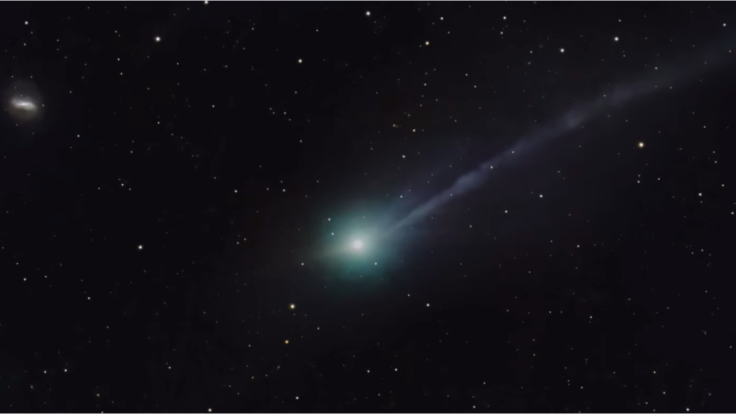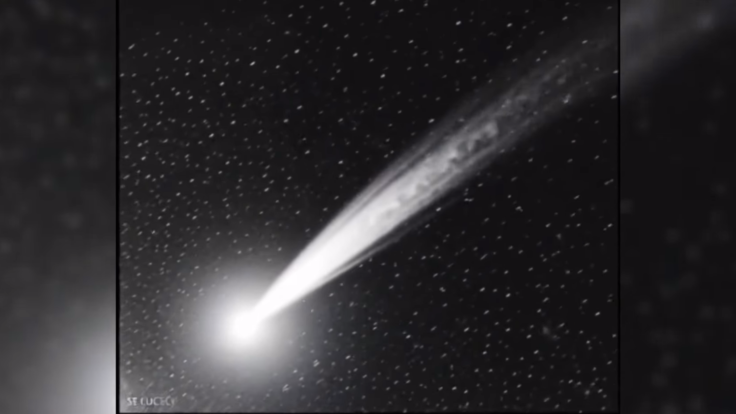3I/ATLAS Update: Space Debris Crisis? Astronauts 'Stranded' As Comet Baffles NASA
See the stunning new image of interstellar comet 3I/ATLAS 'photobombing' a galaxy.

It is a rare celestial spectacle when a wanderer from the furthest reaches of the cosmos pauses to pose for a portrait alongside a distant island universe. Yet, in a breathtaking display of cosmic perspective, the interstellar voyager known as 3I/ATLAS has been caught 'photobombing' a remote galaxy, reminding us of the sheer scale of our universe.
While this remarkable photograph captures the ethereal beauty of the ancient visitor and its complex tail structure, the photographer responsible for the shot is quick to ground the speculation: despite its ghostly appearance, this object was certainly not manufactured by little green men.
Stunning visuals reveal the nature of 3I/ATLAS
Satoru Murata, a dedicated New Mexico-based photographer with a history of contributing to astronomical research, managed to secure this image using a 0.2-metre (0.7 feet) telescope shortly before sunrise on Sunday (Nov. 16). The photograph is a masterclass in astronomical observation, revealing the familiar green glow radiating from the coma of 3I/ATLAS.
Furthermore, it highlights the comet's long ion tail and the fascinating re-emergence of its shorter anti-tail, which is likely caused by excess dust blowing off its surface.' In the weeks leading up to this shot, the comet appeared to lose these distinct tails, but astronomers have since confirmed this was merely an optical illusion created by the comet's specific angle relative to Earth.
Keen observers might also spot smaller jets of gas erupting from the comet's coma. These are the result of 'outgassing', which occurs when solar radiation heats comets' icy interiors, causing gasses to shoot out of cracks in their icy shells.' This seemingly violent natural process acts like a thruster, providing a small amount of non-gravitational acceleration. It was this erratic movement that fuelled a recent rumour which wrongly claimed 3I/ATLAS had exploded.'
Hovering in the top left of Murata's frame is the barred spiral galaxy NGC 4691. While the comet is passing through our own solar neighbourhood, this background galaxy is situated a staggering 70 million light-years away. Seeing the interstellar comet alongside NGC 4691 'really gave the impression of the object being from another world', Murata wrote in a recent Facebook post'.

Debris crisis and 'baffling' anomalies
While the visuals are stunning, the physical presence of 3I/ATLAS has coincided with a potential crisis in Earth's orbit. Reports confirm that six Chinese astronauts are currently stranded aboard the Tiangong space station—operating at double its capacity—after their Shenzhou-20 return craft sustained damage from a high-velocity impact. Beijing has remained secretive regarding the nature of the debris, but analysts are investigating whether this 'unidentified object' was a fragment from 3I/ATLAS's expanding debris trail.
The timing is suspicious, as NASA scientists admit they are 'baffled' by the comet's composition. Spectroscopic analysis has revealed the comet is releasing roughly four grams of nickel per second without any corresponding iron—a ratio never before seen in a natural comet.
Scientific anticipation and the trajectory of 3I/ATLAS
While Murata's photography offers a dazzling aesthetic glimpse, the scientific community is eagerly awaiting a data dump from major space agencies to solve these riddles. Astronomers are on the edge of their seats for new high-definition NASA photos of the comet, which will be released on Wednesday (Nov. 19).' These images were secured by the Mars Reconnaissance Orbiter during the comet's close flyby of the Red Planet on Oct. 3. Unfortunately, these critical assets have remained in the vault due to the recent government shutdown. Meanwhile, on Friday (Nov. 14), the European Space Agency revealed that its own Mars photos had helped researchers narrow down 3I/ATLAS's predicted trajectory through the solar system'.

Alien theories and the reality of 3I/ATLAS
As the third interstellar object ever discovered, 3I/ATLAS was first spotted in early July, shooting toward the sun at more than 130,000 mph (210,000 km/h).' It is an ancient traveller; it likely originates from the 'frontier' region of the Milky Way and could be up to 7 billion years old, making it significantly older than our solar system'.
After its trip around the sun—where it reached perihelion on Oct. 29—the comet experienced an unexpected brightening event and a temporary colour change.' Combined with a highly irradiated surface and an overabundance of certain chemicals,' these anomalies led some to suggest 3I/ATLAS might be an alien spaceship in disguise'.
However, just as they did with the first interstellar visitor, 'Oumuamua, experts agree this is a natural object. Murata is equally convinced.
'No, it's not an alien mothership, and the probability that it's any type of object created by extraterrestrial civilization is close to zero', he wrote in an Instagram post about the new photo'. 'As people have said, if it looks like a duck and behaves like a duck, it's a duck'.
3I/ATLAS will reach its closest point to Earth on Dec. 19, when it will reach a minimum distance of 168 million miles (270 million km) from our planet'.
As 3I/ATLAS races towards its closest approach to Earth on Dec. 19, it remains a celestial paradox: a visual masterpiece for astrophotographers and a potential hazard for those in orbit. With its unprecedented nickel emissions and the looming questions regarding the Tiangong incident, this interstellar visitor is proving to be far more than just a passive traveller.
© Copyright IBTimes 2025. All rights reserved.




















